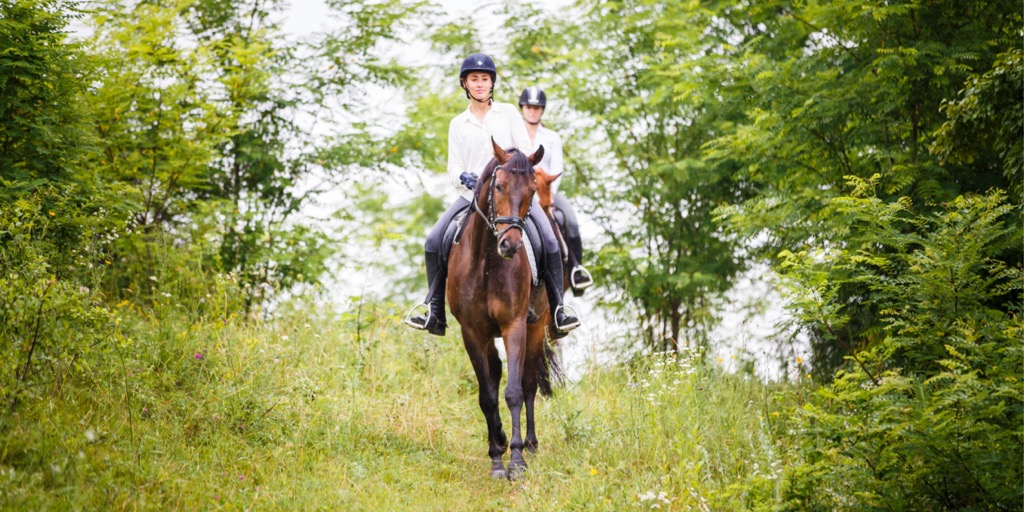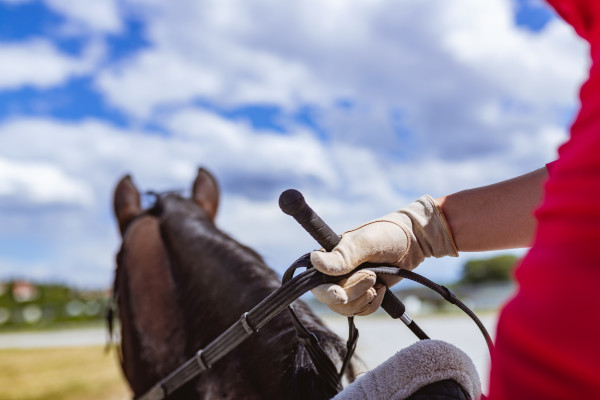Home > Horse Care > Active rest: Three ways to keep your horse in shape while preventing burnout
Active rest: Three ways to keep your horse in shape while preventing burnout
- December 5, 2025
- ⎯ Jeanne O'Malley
In Australia we have a saying that goes, “A change is as good as a spell.” It means that if you are feeling tired, don’t stop and rest—do something different. Now, if you’re exhausted from cleaning stalls, switching to cleaning water buckets probably doesn’t sound particularly restful, but the “change is good” principle is worth keeping in mind when training horses.
Developing new skills, whether they are needed to succeed in competition or to simply perform well as a trail or pleasure horse, does require a bit of work. And the best route often involves drills designed to produce incremental improvements in movement, gait or fitness with each session. It then becomes easy to adopt a mindset that makes meeting goals the priority while minimizing other considerations.
“Riders want to practice and refine their skills, and they are probably worried about disrupting the training program if they do anything but formally train,” says Hilary M. Clayton, BVMS, PhD, DACVSMR, FRCVS, who held the Mary Anne McPhail Dressage Chair in Equine Sports Medicine at Michigan State University for 17 years. “So every day they go into the arena, perform the same routine, then take the horse back to the stall.”
This kind of routine can take a toll on a horse, both mentally and physically. Not only is he likely to get bored, but his muscles, tendons and ligaments don’t have time to fully recover from the demands placed on them. If a horse is asked to exert himself in the same way day after day, then his body doesn’t have a chance to repair itself, which means that tiny injuries accumulate.
So, just like us, horses need to take periodic breaks from work. But giving your horse time off to just stand around isn’t the best idea. “Twenty-four hours in a stall isn’t beneficial, and no sound horse needs the kind of rest that verges on immobility, which results in deterioration of the locomotor tissues” says Clayton. “There are better solutions than ‘bed rest’ to let your horse recover, and these should be part of a good training and maintenance program.”
One alternative is to follow the lead of human athletes who engage in the practice of active rest, also known as active recovery.
For people that means taking days off from their usual primary activity—weight training, distance running, bicycling—and instead doing yoga, going for a swim or taking a walk. The idea is to take a break by engaging in a low-impact activity that keeps the body moving while using different muscle groups.
It may be a little more complicated to incorporate the principles of active rest into your horse’s training regimen, but the effort is well worth it. The key, Clayton explains, is to make changes in activity, not a cessation of it. “Clearly there is nothing like studying work to teach you a lot about rest. And I’ve learned that the best rest for athletic horses is ‘active rest.’ Rather than completely stopping activity, try changing the intensity, the type, the pace, the direction, or even where you do the work.”
Here are her suggestions for making “active rest” work for your horse.
1. TRY DIFFERENT ACTIVITIES.
At least once or twice a week, do something completely different with your horse: Take your dressage horse out on the trail or to the beach; play gymkhana games with your Western pleasure mount; or work on collection and side passes in the arena with your endurance horse—you get the idea.
At the end of a show or competition season, consider switching to a different activity entirely for a time—a “working vacation” for both you and your horse. “Two to three weeks of trail riding or herding livestock will refresh our competition horses after concentrated mental and physical work,” says Clayton. “Competition riders sometimes embrace too enthusiastically the idea that their sport requires a disciplined approach, and they forget that the goal should be a happy, healthy horse.”

And don’t worry that simply switching up activities will not give your horse enough of a break. “The problem for most people is not working the horse too much—in fact, most people don’t work their horse very much at all,” says Clayton. “But they do work their horses with too much ‘same’: the same routine practiced every day, the same movements, in the same order, in the same arena.” Cross-training, which incorporates different types of activities in the exercise program, will not only keep your horse more sharp mentally but will help preserve his soundness. Cross-training, which incorporates different types of activities in the exercise program, will not only keep your horse more sharp mentally but will help preserve his soundness.
Cross-training, which incorporates different types of activities in the exercise program, will not only keep your horse more sharp mentally but will help preserve his soundness. “Constant drills on the same movements can result in a sort of equine repetitive strain injury,” says Clayton. “If you stress the same parts of the body over and over again, without giving them time to recover, those body parts start to suffer. Over time they accumulate damage which may lead to pulled suspensories and bowed tendons.”
She adds, “Cross-training allows the horse to develop a diverse set of athletic skills while avoiding the mistake of doing the same thing day after day.”
2. DEVELOP COMPLEMENTARY SKILLS

You can use active rest to address issues you’ve been having in your usual training regimen. For example, says Clayton, “doing an activity that is more inherently exciting to a horse than dressage or showing, such as cross-country, jumping or stock work, can develop impulsion and forward movement in a horse lacking these attributes. Quiet hacking can help develop calmness and reduce stiffness in horses who are inclined to become hotheaded and tense. Hill work on a long rein helps develop a longer, lower frame and encourages development of the propulsive muscles. A good endurance horse benefits from a workout in the dressage arena and testing the suppleness on the left and right sides of the body reminds the rider of the need to change diagonals periodically when out on the trail.”
Even a change of scenery gives a horse mental stimulation without taxing his body. You can still pause and request the occasional side pass or a few steps of collection while you’re out on the trail. The unusual surroundings not only give your horse a break from his usual work, they also help to build his confidence and teach him to take new experiences in stride. When you go back to the show ring, he will be more likely to accept working in strange situations while still paying attention to your cues.
3. PROVIDE THE RIGHT KIND OF REST
Sometimes actual rest, with no riding at all, is beneficial for a horse—after a 100-mile endurance ride or three-day event, for example, or at the end of a long, busy show season. But he needs more than just a break from physical exertion—you want to give him time to relax mentally and just be a horse for a while. And that means having time to relax in a less stressful environment, such as moving around in turnout with friendly companions rather than standing in a stall.
“You can rest a horse outdoors in a paddock for a couple of weeks and you won’t lose a significant amount of fitness,” says Clayton. “But complete ‘bed rest’ in a stall for a longer period will cause a loss of strength and fitness. So unless the horse is actually under a veterinarian’s orders, complete stall rest is not a good idea.”
That said, too much of a good thing can be bad for a horse’s fitness, too. “Formerly, it was the tradition to pull the shoes and turn horses out in good pasture after a season of polo, racing or hunting. This holiday lasted until a few weeks before the next polo, hunting or racing season,” says Clayton. “We now realize that it’s not a good idea to totally let down hunters, eventers and other hard- working horses—it’s far better to keep them active by working them lightly three to four days per week, which is enough to maintain a baseline level of fitness and for them to be brought back more quickly for the next competitive season. ”
A horse who rests on pasture all winter will need careful reconditioning to restore his fitness the next spring.And he’ll be more prone to injury during that recovery period. Instead, to keep up your horse’s level of fitness, try to continue riding—even if under a reduced workload—throughout your off-season. As long as the footing isn’t treacherous and you allow enough time to warm up, you can safely ride outside in cold weather.
Keep in mind that frozen ground can be as hard as concrete—if your horse isn’t leaving visible hoof prints, you’ll want to stick to a walk. In harsher climates, an indoor ring may be the best option for winter workouts.
“I ride, and I show,” says Clayton, who competes in dressage. “I hack out and enjoy the summer weather, but in winter the challenges are different. Michigan weather can prohibit outdoor training for weeks. So I plan different types of work in the indoor arena—I ride forward, round and relaxed one day, then do collected work and strength-training the next, and focus on suppleness another day. It works!”
Adding different activities to your horse’s training schedule may seem complicated, and it may help to write out a calendar to make sure you’re finding the right balance. “Plan a schedule or, better still, have a master plan for the entire competition season then break it down into detailed two-week blocks that will allow you to achieve the long-term goal in easy stages” advises Clayton. “In some ways the amateur rider has it easier than the professional trainer. The need to balance work, school and family life sometimes necessitates taking a break that is also beneficial for the horse.” And, in the long run, that may be healthier for both you and your horse.
Don’t miss out! With the free weekly EQUUS newsletter, you’ll get the latest horse health information delivered right to your in basket! If you’re not already receiving the EQUUS newsletter, click here to sign up. It’s *free*!





